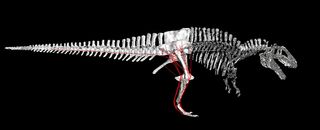Digital Paleontology Reveals Dinosaur Details

The pick and shovel can go only so far in digging up details about dinosaurs. Now supercomputers are revealing knowledge about their anatomy otherwise lost to history. Although some lucky paleontologists manage to reconstruct the complete skeletons of extinct creatures, there remains much about their anatomy that remains a mystery. For instance, while features of bones can tell one where muscles were attached, they do not tell you how long these muscles were. This can lead to startling differences in the pictures that artists draw of how the animals looked in life. For example, if the muscles connected to the thigh bone of a Tyrannosaurus rex were short, that would suggest it was angled vertically as in humans. However, if they were very long, it could have been angled horizontally as in birds. This is one way a new field of science known as computer paleontology can shed light on details of dinosaurs not available any other way. For instance, researchers Bill Sellers and Phil Manning at the University of Manchester in England place virtual muscles onto digital versions of dinosaur skeletons to figure out how these goliaths once walked. Initial attempts to randomly decipher which pattern of muscle activation works best result almost always in the animal falling on its face, explained computer paleontologist Peter Falkingham at the University of Manchester. But the scientists employ "genetic algorithms," or computer programs that can alter themselves and evolve, and so run pattern after pattern until they get improvements. Eventually, they evolve a pattern of muscle activation with a stable gait and the dinosaur can walk, run, chase or graze, Falkingham said. Assuming natural selection evolves the best possible solution as well, the modeled animal should move similar to its now extinct counterpart. Indeed, they have achieved similar top speeds and gaits with computer versions of humans, emus and ostriches as in reality. Falkingham investigates fossilized tracks, such as footprints. "Tracks can tell you so much that skeletons can't," he told LiveScience. "They can tell you about the soft parts of the feet that weren't preserved over time. They can tell you how the animal moved, how it walked or ran. They can even tell you about the environment they lived in, and perhaps show you they may have moved considerable distances." The problem with tracks is that they can be very hard to interpret, as the number of variables involved with how tracks form "is staggering," Falkingham explained. "Is the sediment made of tiny clay particles that stick together, or larger sand particles that roll over? What is the water content, which can help particles stick together, but if you put in too much, it pushes particles apart? What is the strength, elasticity and compressibility of the soil? And what happens when you have layers of sediment? The impressions left behind at lower layers can be very different from the ones left on the surface." Physically recreating each potenial scenario with a real box of mud is extraordinarily time-consuming and difficult to repeat accurately, so this is where computer simulation comes in. Falkingham employs computer simulations to see what tracks form when virtual feet touch down on digital soil. They can then chop up this footprint and view it from any angle, which can prove necessary if paleontologists only have part of a track to investigate. By running hundreds of simulations on supercomputers at the same time, they can start to figure out what types of footprint would be expected if an animal moved in a certain way over a given type of ground. Sometimes the experiments can throw up unexpected results. Falkingham added. For instance, when he was once simulating wet, sloppy mud to see how an extinct bird walked — findings that could shed light on how birds evolved from dinosaurs — once the result was a webbed footprint, even though the foot itself was not webbed. The virtual soil had been pushed up between the toes, before collapsing into a platform-like structure that, in a fossil track, could be interpreted as the impression left by a webbed foot. The soft parts of animals, such as webbing, only rarely gets preserved as fossil, so much of the evidence for the evolutionary history of webbed-footed-birds comes from tracks, Falkingham said. These results call for careful reinterpretation of webbed footprints. Now Falkingham is also investigating four-legged dinosaurs. "It's great to not only see dinosaurs in death, but also how they might have lived," he said. Falkingham discussed computational paleontology on March 31 at the UK Natural Environment Research Council's news site "Planet Earth."
- Dinosaurs: News and Information
- Video – Finding the 'Leonardo' Fossil
- Avian Ancestors: Dinosaurs That Learned to Fly
Sign up for the Live Science daily newsletter now
Get the world’s most fascinating discoveries delivered straight to your inbox.

